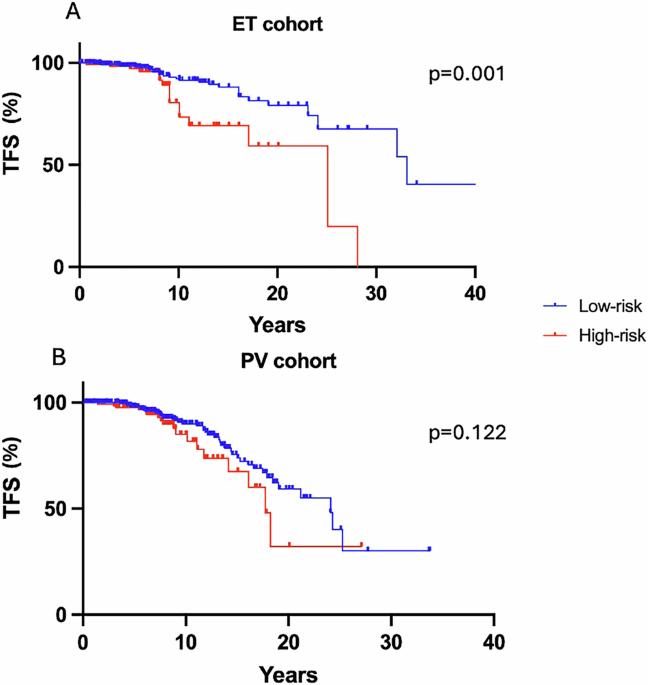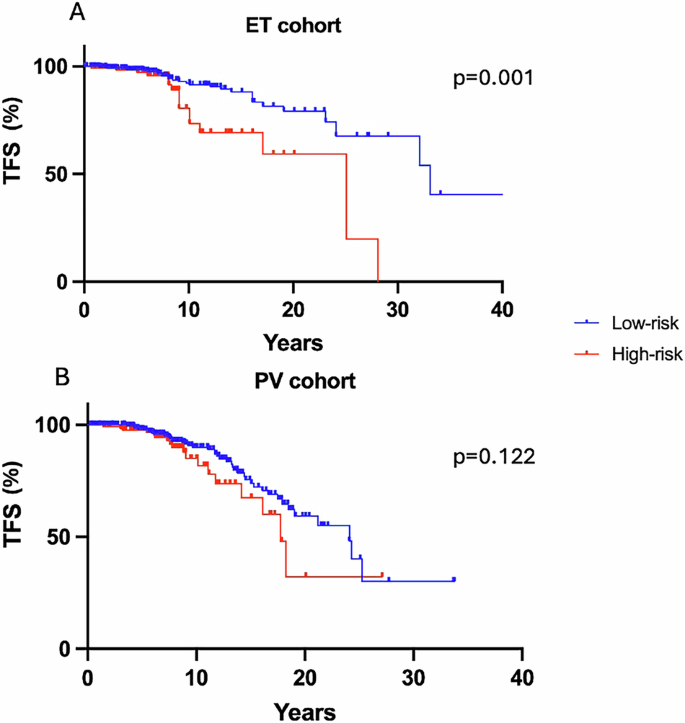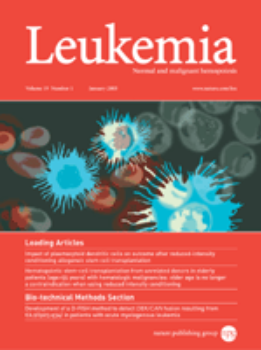QRISK3 score is predictive of thrombotic risk in patients with myeloproliferative neoplasms
IF 13.4
1区 医学
Q1 HEMATOLOGY
引用次数: 0
Abstract
Thromboembolic events (TE) represent the commonest cause of morbidity and mortality in polycythemia vera (PV) and essential thrombocythaemia (ET). The QRISK3 model is a tool for predicting TE in the general population, with 7.5% recognised as a threshold to identify high-risk patients. We analyzed data of 937 patients (490 ET and 447 PV) with a median follow-up of 85 and 95 months, reporting an occurrence of 52 and 73 TE, respectively. Median QRISK3 scores at diagnosis were higher in conventional high-risk patients in both cohorts (ET; 4.2 in high-risk vs. 2.4 in low-risk, PV; 8.8 vs. 2.8, p < 0.001). During follow-up, a QRISK3 score greater than 7.5%, demonstrated potential to further stratify individuals at high risk of TE, outperforming standard risk assessments in both low and high-risk patients. Using cytoreductive treatment instead of active surveillance in patients with QRISK3 ≥ 7.5% conferred a reduced risk of thrombosis in both cohorts. Of this group, 79.7% with ET and 86.9% with PV, on cytoreductive therapy, remained thrombosis free, compared with 64.1% and 57.1% of those not receiving cytoreductive therapy (p = 0.018/0.034). QRISK3 identifies patients in whom cytoreductive therapies may be indicated, and provides a tool that allows patients to assess, monitor and reduce their cardiovascular risk.


QRISK3评分可预测骨髓增殖性肿瘤患者的血栓形成风险
血栓栓塞事件(TE)是真性红细胞增多症(PV)和原发性血小板增多症(ET)中最常见的发病和死亡原因。QRISK3模型是一种预测普通人群TE的工具,7.5%被认为是识别高危患者的阈值。我们分析了937例患者(490例ET和447例PV)的数据,中位随访时间为85个月和95个月,分别报告了52例和73例TE。在两个队列中,常规高危患者诊断时的中位QRISK3评分较高(ET;高危组为4.2,低危组为2.4;8.8 vs. 2.8, p < 0.001)。在随访期间,QRISK3评分大于7.5%,显示出进一步对TE高风险个体进行分层的潜力,在低风险和高风险患者中都优于标准风险评估。在QRISK3≥7.5%的患者中,使用细胞减少治疗而不是主动监测可以降低血栓形成的风险。在该组中,接受细胞减少治疗的ET患者中有79.7%和PV患者中有86.9%没有血栓形成,而未接受细胞减少治疗的患者中有64.1%和57.1%没有血栓形成(p = 0.018/0.034)。QRISK3识别可能需要细胞减少治疗的患者,并提供一种工具,允许患者评估、监测和降低心血管风险。
本文章由计算机程序翻译,如有差异,请以英文原文为准。
求助全文
约1分钟内获得全文
求助全文
来源期刊

Leukemia
医学-血液学
CiteScore
18.10
自引率
3.50%
发文量
270
审稿时长
3-6 weeks
期刊介绍:
Title: Leukemia
Journal Overview:
Publishes high-quality, peer-reviewed research
Covers all aspects of research and treatment of leukemia and allied diseases
Includes studies of normal hemopoiesis due to comparative relevance
Topics of Interest:
Oncogenes
Growth factors
Stem cells
Leukemia genomics
Cell cycle
Signal transduction
Molecular targets for therapy
And more
Content Types:
Original research articles
Reviews
Letters
Correspondence
Comments elaborating on significant advances and covering topical issues
 求助内容:
求助内容: 应助结果提醒方式:
应助结果提醒方式:


